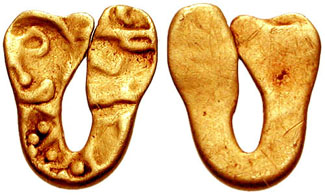- Lari (fish hook money)
Coin image box 1 double
header = Gold Indian Larin

caption_left = Three punches: two with Kannada inscriptions, one with uncertain animal.
caption_right =
width = 300
footer = Circa 12-13th century, from "Walve Hoard"
position = right
margin = 0Larin (plural: lari) is the name of a class of objects serving as coins in areas around the Arabian sea. The name is derived from Lar, a Persian town that according to tradition would have been the first to produce lari. A larin was a piece of silver wire of about 10 centimeters long, usually folded in two equal parts and shaped like a C, though there are also lari shaped like a J, an I or an S. Lari were stamped with an Arabic or Persian text, usually the name of the local ruler. The I was most popular among the Arabs and Persians, while the J and S were typical for the island of Ceylon. The latter were known as "koku risi" (silver hook) among the Sinhalese.
A 17th century larin would weigh about 4.75 grams. It was traditionally tariffed at 5.5 lari to the Spanish colonial piece of eight.
Lari is the root of coin denominations used in Georgia and the Maldives.
Reference: The Silver Larin, by M. K. Husain in "Journal of the Numismatic Society of India", Vol. XXIX, Part II (1967) pages 54-72.
Wikimedia Foundation. 2010.
